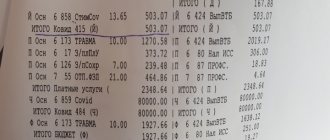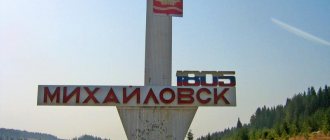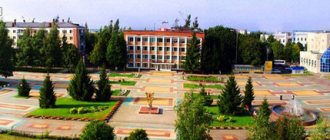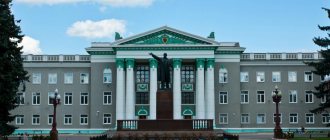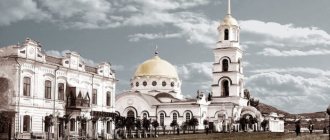Welcome to the city portal of the city of Noginsk
The city of Noginsk is located in the east of the Moscow region, on the banks of the river. Klyazma.
Since 2022, it is the center of a new municipal formation - the Bogorodsky urban district. The district received its name in honor of the old name of Noginsk - Bogorodsk before 1930. In 2013, the city received the status of a historical settlement.
The city's population is 102,295 people as of 2022.
History of Noginsk
In 1389, the village of Rogozhi was founded, the name of which came either from the name of the Rogozha River, or from the name of the fabric that was produced by local residents. And for the first time this village was mentioned in the charter of Dmitry Donskoy
In 1506, the settlement received the status of Yamskaya Sloboda and consisted of 38 households. In the fall of 1781, by decree of Empress Catherine II, the village of Rogozha was renamed the city of Bogorodsk. The city's development was driven by textile factories; at that time there were up to 80 enterprises, most of which produced silk. Gradually the city turned into one of the largest cities in the Moscow region.
In September 1812, the army of the French Marshal Ney stopped in Bogorodsk; it plundered and destroyed most of the city. After the French retreat, the city was quickly restored and even increased the number of residents by 20%.
In the middle of the 19th century, the city began to rapidly grow and develop, buildings and shopping arcades were built, and the Bogorodsko-Glukhovskaya manufactory was built. Several estates appeared outside the city.
In 1927, Bogorodsk became the administrative center of the newly formed Bogorodsky district. In 1930, Bogorodsky district was renamed Noginsky, and the city of Bogorodsk received a new name Noginsk. Before the Second World War, several more large industrial enterprises opened their doors in the city.
During the Great Patriotic War, Noginsk played an important strategic role, as it was an industrial and transport center. Products for the needs of the front were produced here; a large number of trains passed through the city to the sites of combat operations. The battles themselves did not take place in the city, but thousands of residents of Noginsk and the region went to the front.
In the post-war years, the construction of industrial enterprises and multi-apartment residential buildings actively developed in the city.
Due to the difficult economic situation in the 1990s, a number of city enterprises ceased to exist as a result of bankruptcy.
Thanks to the city administration, large-scale improvement work was carried out in Noginsk in the 2000s.
Economy of Noginsk
The Borilovsky industrial complex plays a leading role in the city’s economy, with new production facilities opening here every year.
The city is home to enterprises that carry out the following activities:
— food industry;
- light industry;
— production of building materials;
— mechanical engineering;
— furniture industry;
— Media: TV channel and radio of Noginsk, two municipal newspapers (“Bogorodskie Vesti” and “Volkhonka”).
Food industry enterprises produce fat and oil and bakery products, ice cream, flour and animal feed, meat products and fish processing, and brew beer.
Mechanical engineering enterprises produce commercial refrigeration, confectionery, hydraulic, welding, boiler auxiliary and water treatment equipment, industrial diagnostic equipment, electrical products, fuel equipment, and agricultural machinery.
Manufacturers of construction and finishing materials produce ceramic sanitary ware, porcelain stoneware, building mixtures and reinforced concrete products, laminate, lumber, metal structures and metal-plastic pipes, roofing and waterproofing materials.
Noginsk also produces artistic cast and forged products, metal doors, plastic containers for the food and chemical industries, rubber products, furniture, household and technical tapes, and sewing products.
There are also 17 institutions of all systems and departments located here, including:
· 5 cultural and leisure institutions, three of them are municipally owned;
· 2 libraries, one of them is municipally owned;
· 1 museum;
· 1 cinema;
· 1 State Institution "Noginsk Regional Drama Theater";
· 4 municipal educational institutions of additional education for children (art school, art school, center for children and youth creativity, music school);
· 2 parks of culture and recreation (City Park of Culture and Recreation and Glukhovsky Park of Culture);
· 1 Noginsk Municipal Pop Brass Band.
Architecture and sights of Noginsk
The monumental empire-style Epiphany Cathedral of the 19th century with a wide domed rotunda defines the architecture of the center of Noginsk and is the main attraction.
The Church of the Tikhvin Icon of the Mother of God, the administrative complex with government buildings, prisons, service outbuildings, the Elagin house, the house of P.S. were built in the Russian-Byzantine style. Zotov in the neo-Renaissance style, wooden houses, including the Erokhov house of the late 19th - early 20th centuries. All these are buildings in the central part of Noginsk.
Also, the buildings of a girls' gymnasium, a real school, the Sopovs' house, etc. were built in the Art Nouveau style. Behind the railway station, the Old Believer Church of the Holy Prophet Zechariah and the Great Martyr Evdokia was erected in the neo-Russian style. In 2000-2002, the Church of the Holy Martyr Constantine of Bogorodsky was built.
Monument to V.I. Lenin, the local history museum, branches and representative offices of Moscow universities, the drama theater of the Moscow region, the central regional library - determine the appearance of the city.
The ensemble of the former estate of G.P. Klyuev is located east of the city center: a baroque Assumption Church of the “octagon on a quadrangle” type with an additional tier of bells, a 2-story house, and a park.
In the 1900s, a church was erected in Glukhov in honor of the Smolensk Icon of the Mother of God (formerly the chapel-tomb of I.M. Vlasova), and the buildings of the Association of the Bogorodsko-Glukhov Manufactory in the Art Nouveau style.
The most beautiful place in the center of Noginsk is Fountain Square. Special lighting operates at night and attracts tourists and city residents there.
You can cross Klyazma via a small pedestrian bridge - the Bridge of Lovers. According to tradition, as a symbol of eternal love, people in love decorate the bridge railings with small locks.
To the north-west of Noginsk are located:
- in the village Voskresenskoye - wooden Ascension Church of the 18th century and the Church of the Intercession in the Empire style of the 19th century;
- in the village Avdotino is a complex of the Nikolaev Berlyuk Hermitage of the 18th century: the summer five-domed Cathedral of Christ the Savior, the winter Trinity Cathedral, a multi-tiered bell tower, etc.
West and southwest of Noginsk:
- in the village Ivashevo - the estate of the Nebolsins Troitskoye-Ratmanovo, which includes the Trinity Church with a Doric colonnade, a landscape park;
- in the village Balobanovo - Trinity Church in the spirit of medieval Armenian architecture of the early 20th century.
Church of the Assumption of the Blessed Virgin Mary
- In 1756 the temple was consecrated, after completion of construction the village began to be called Uspensky
- In 1856, a chapel was added to the temple in the name of the Holy Twelve Apostles
The temple was erected in the mid-18th century with donations from the merchant Gabriel Klyuev. The author of the architectural project is unknown. This is a brick building, the facade of which is modest and discreet, but at the same time elegant and attractive. In the 19th century, a bell tower and a refectory were added to the church. Today, services are constantly held here. A Sunday children's school is open at the church. Although classes and conversations are also held with adults. There is a library. Activities for children's development are popular.
Media and communications
The city is located within the coverage area of the Ostankino TV Tower and Balashikha Radio Mast transmitters.
Radio Noginsk (104.9 MHz) and the Noginsk TV channel (together with the Podmoskovye TV channel on 28 TVK) are broadcast from the city; Radio Russia (107.2 MHz) is rebroadcast. There is a cable television network broadcasting 30 channels.
Two municipal newspapers are published (one twice, the other three times a week, with a total circulation of about 40 thousand per week), a monthly newspaper of the Bogorodsky Deanery of the Russian Orthodox Church with a circulation of 14 thousand, and several advertising newspapers.
There are computer networks of the companies Flex, ArtEx and Corbina Telecom, the latter also provides television.
Fixed telephone communications are provided by the central telecommunications center (CenterTelecom), and postal communications are provided by a wide network of Russian Post offices.
A powerful communication line has been laid through the city through TCMS-21146 Rostelecom (Noginsk) to M10 (Moscow), there is a satellite communication center.
Internet providers: Flex, ArtEx, NTK, Elcatel, CenterTelecom, Corbina Telecom. Mobile operators also provide mobile Internet: VimpelCom (GSM (BeeLine), MTS (GSM), MegaFon (GSM), Sky Link (NMT-450, CDMA2000).
Top attractions (15)
alphabetically by popularity
Voskresenskoye29
The village of Voskresenskoye was first mentioned in documents from the early 17th century. Moreover, from these records we learn that it already existed in the 16th century, but exactly when it was built is not established. Voskresenskoye was located on land that was part of the royal hunting grounds.
Assumption Church in Bogoslovo14
The Assumption Church in Bogoslovo was built in the 19th century. In the 40s of the said century, the refectory and the main building of the temple were erected, and in the 50s the bell tower was built. It should be noted that the first stone temple was located here in the 18th century.
Elektrougli14
The history of the city of Elektrougli begins in the 30s of the 20th century. During that period of time, a workers’ settlement of the same name arose near, founded at the end of the 19th century, which received the status of a city in the 50s of the 20th century.
Nikolo-Berlyukovskaya hermitage10
Nikolo-Berlyukovskaya Hermitage is a monastery founded in the 17th century. Its story began like this: the monk Varlaam, who escaped from a monastery destroyed by the Poles, came to the site of the future monastery. Legend has it that soon, having settled in these places, the elder nuns of one of the monasteries located nearby came to him.
Church of the Intercession in Kudinovo10
The wooden Intercession Church was built in Kudinovo in the 17th century. At that time, the village was the property of the Duma clerk F. Likhachev. At the beginning of the 19th century, when Prince Dolgorukov became the owner of the village, a stone church was erected.
Staraya Kupavna10
Staraya Kupavna, located on the Kupavinka River and named after it, became a city not so long ago - in 2004. In 2022, the village of Akseno-Butyrskoye was annexed to it. The village, which was previously called simply Kupavna, and in the 17th century was called Witch’s Corner, has been known since the mid-14th century, although it was probably founded much earlier.
Makarovo9
In historical documents, the village of Makarovo was first mentioned in the 16th century. Moreover, the village is mentioned in connection with the construction of the wooden church of St. Nicholas the Wonderworker. This building has not survived to this day (it was destroyed in a fire).
Church of the Assumption of the Blessed Virgin Mary in Stromyn9
The Assumption Church in Stromyn was built in the first third of the 19th century. Funds for the construction of the church were donated by parishioners. The building complies with the canons of the Empire style. The temple was built of brick, the base is made of white stone.
Epiphany Church in Biserovo8
The date of construction of the wooden Epiphany Church in Biserovo is not precisely known, but in the 18th century, obviously, the temple already existed. It is known that during the Patriotic War of 1812 it was desecrated by the French invaders.
Church of the Nativity in Yamkino8
The Nativity Church in Yamkino was first mentioned in historical documents dating back to the first third of the 17th century. However, some historians believe that the church was founded no later than the 16th century.
Ivashevo7
When telling the history of the village of Ivashevo, we need to talk first of all about the history of the Trinity Church. The temple was built in 1810 (according to other information - in 1815). As a matter of fact, this church was originally built in the village of Troitskoye, which in Soviet times was united with the village of Ivashevo.
Elias Church in Mamontovo7
The Ilyinskaya Church in Mamontovo is mentioned in texts of the 17th century - however, on the territory where it was located, at that time there was no village, but the Muravischi churchyard was located. Already in these ancient documents it is emphasized that the temple was built long before it was mentioned.
Peter and Paul Church in Obukhovo7
According to ancient chronicles, the wooden Peter and Paul Church was built long before the Time of Troubles. The exact date of construction, however, is still unknown. Over time, the temple became dilapidated, and in the middle of the 18th century, a new wooden church was erected in Obukhovo, located not far from the old one.
Church of St. Sergius of Radonezh in Novosergievo6
The Sergius Church in Novosergievo was founded in the late 30s of the 19th century. Its construction was completed in the 40s of this century. At that time, the owner of the village was the famous philanthropist Anatoly Demidov.
Kazan Church in Ivanisovo5
The Kazan Church in Ivanisovo was built at the beginning of the 19th century on the site where the wooden temple of the Archangel Michael previously stood. The customers for the construction work, which lasted seven years, were Lieutenant General Ilovaisky and Adjutant General Sinyagin.
Noginsk House of Artists
The Noginsk regional branch of the Union of Artists of Russia is a public organization conducting active exhibition activities
This is a public organization that conducts active exhibition work. The House of Artists has an exhibition of masters in various fields. Their canvases may differ in technique and genre. Many of the artists were awarded the honor of “Honored Artist of the Russian Federation”, namely: V.A. Orlov, Yu.V. Moshkin, M.A. Poletaev, F.E. Makhonin and others. The gallery exhibits not only paintings. You can see sculpture, as well as objects of decorative and applied art, for example, designer clothes and accessories, tapestry, etc.
Epiphany Cathedral
Address: Noginsk, Rabochaya st., 16A.
In the historical center of Noginsk there is the Epiphany Cathedral, built in 1755-1767 in the style of late classicism. It is the architectural dominant of the center of Noginsk. A stone temple appeared instead of a wooden church, and the money for its construction was donated by parishioners. In the 19th century, the main building of the temple was badly worn out, so it was replaced with a new large temple, and a four-tiered bell tower and a refectory were built nearby.
In the 20th century, the Epiphany Cathedral was empty for a long time, and in 1989 it was restored, decorating the interior with carved iconostases and completely returning its former appearance.
Ecology and nature
The city of Noginsk is located on the banks of the Klyazma River. Its tributary (Sherna) is considered the cleanest river in the Moscow region. The Noginsk region is rich in lakes, and one of them, Biserovo, is unique in its glacial origin. The climate of Noginsk and the Noginsk region is extremely favorable for organizing health-improving complexes here. This region is famous for its mineral springs, and the lakes are rich in healing peat mud. The nature of these places pleases the eyes and heart.
Within the city there are two large parks - Central and Glukhovsky. The latter has its own boat station on Chernogolovsky Pond, where there is also a recreation area on the beach. The Volkhonka Arboretum is located in the suburbs; it is located on the left bank of the Klyazma. Numerous recreation areas are also located on the Klyazma River.
Sport
In the Glukhovo microdistrict there is a sports complex "Znamya", which includes an illuminated stadium with a football field, running tracks and a concrete bicycle track, two indoor buildings for training and competitions with a modern basketball hall, a small football field with a high fence, a hockey rink and a parking lot. The complex is located on the shore of Chernogolovsky Pond, surrounded by a large forest area used for training, competitions and just relaxation. The Spartak-Noginsk women's basketball team, the strongest team in the second women's division in 2010, trains in the complex's basketball hall.
The main football stadium, located in the Avtomobilist sports complex, located in the city center, has stands with a capacity of 2000 people. The stadium is the home base of the SDYUSHOR-Noginsk team; from 2001 to 2009, the Nadezhda women's club also trained here. In addition to the football field, the complex includes running tracks, an outdoor tennis court with rubber coating, a mini-football court, gymnastic equipment and an unfinished indoor building, and next to the complex there is another small football field.
There is a small sports complex “Start” with a stadium in Domozhirovo, a stadium with an outdoor basketball court on Oktyabrsky and a stadium in Istomkino.
There is a Children's and Youth Sports School in the city, one of the school's students is the famous football player Renat Yanbaev. There are many sports sections and schools, the most famous of which is the Boxing School.
There is a station for young tourists that supports active recreation, including sports tourism and extracurricular education.
In the 90s, on the basis of ROSTO (DOSAAF) on the city pond, motorboat competitions were held in the youth class.
Since the early 1990s, construction of a large sports complex has been underway in the Zarechye region.
Do you know what?
- The world's first monument to Lenin was erected in Noginsk. After this city, monuments began to be erected in other cities.
- Noginsk is the first city near Moscow to acquire electric transport. On March 2, 1924, tram service was opened, as they say, this happened on the personal initiative of M.I. Kalinin. Industrialists and residents of the city of Bogorodsk, as Noginsk was then called, dreamed of a tram since the beginning of the last century, and design work was completed even before the revolution.
- The economy of the city of Noginsk is represented by industrial production, trade and catering enterprises, transport and communications, and housing and communal services enterprises.
- Since 2003, Noginsk has been taking prizes in terms of improvement: reconstruction in the historical part, construction of new buildings, landscaping. Residential construction of apartment buildings and microdistricts is actively underway.
Famous people
- Pavel Alexandrov (1896–1982), mathematician
- Grigory Fedotov (1916–1957), association footballer
- Vladimir Fortov (1946-2020), physicist, member of the Russian Academy of Sciences
- Vladimir Korotkov (born 1941), professional football coach, former player
- Anatoly Ivanovich Lipinsky (born 1959), rear admiral
- Pimen I of Moscow (1910–1990), head of the Russian Orthodox Church.
- Vladimir Serbsky (1858–1917), one of the founders of forensic psychiatry in Russia.
- Igor Spassky (born 1926), submarine designer.
- Igor Talankin (1927–2010), film director and screenwriter.
- Renat Yanbaev (born 1984), association footballer


